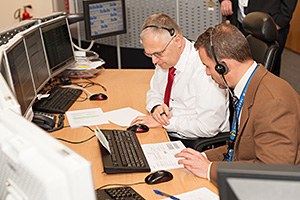Software update for Columbus
The difference isn't much of a surprise – a precise 'transition schedule' is defined months in advance. It's not enough to simply 'transport' the software to the International Space Station (ISS). The astronauts themselves have to be available for several days, while the ground system needs to be ready. All of this requires an immense amount of coordination.

I can also obtain detailed information on what will change with the new software; either I ask the flight directors responsible for the transition, my colleagues Torsten Gehrke and Gustav Öffenberger, or I simply check the documentation to see a precise description of what the upgrade contains. Every problem, each request for improvement, was logged in a 'System Problem Report' (SPR); the appropriate 'Control Boards' dispositioned these in numerous meetings and used the results to create new software for Columbus. The 'Software Control Board' then released this for implementation.
And there's another difference. The update message doesn't annoy millions of people, as there is only one user – the space laboratory Columbus, with its onboard computers and the closely linked database back on Earth.
We recently updated Columbus with 'Software Cycle 14'. Besides numerous minor improvements, we readied our space laboratory for two new exterior experiments that will be flown to the ISS on board the SpaceX spacecraft CRS-3 and CRS-4.
These are the external camera HDEV, intended to deliver high-resolution images of Earth, and RapidScat, an instrument that uses microwave measurements to reveal winds and storms over the oceans. Now the European laboratory is ready for new and exciting science.
But the new software is only 'halfway there' in our ground system; safety protocols dictate that only two of our three control rooms have been updated to 'Cycle 14'. If a serious bug is detected despite the extensive testing, we can restore the old software version at any time; all it takes is a reconfiguration on board and we simply move back to our main control room K4, which remains 'locked down' until everyone is confident about 'Cycle 14'. We will operate Columbus from control room K3, which is mainly where we conduct simulations, until K4 has been updated to the new software.
So in some ways the automatic updates on my laptop have their advantages –bringing Columbus up to date is a cumbersome affair…

Flight Controller in the Columbus control room. All photos: DLR/Christian Ehrhardt.
Tags:
